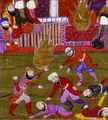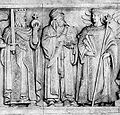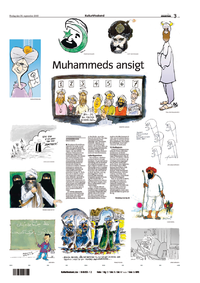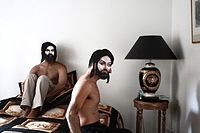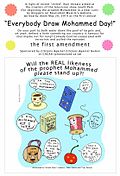- Depictions of Muhammad
-
A series of articles on
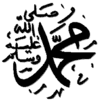
Prophet of Islam
Muhammad
Life
In Mecca · Hijra · In Medina · Conquest of Mecca · Wives · Farewell pilgrimage · Family tree ·
Career
Qur'an · Hadith ·
Early reforms under Islam · Diplomacy · Military · Persecution by Meccans · Migration to Abyssinia ·
Miracles
Isra and Mi'raj · Relics · Splitting of the moon ·
Al-Masjid al-Nabawi ·
Views by subject
Jewish · Christian · Slavery ·
Succession
Farewell sermon · Saqifah · Pen and paper · Family · Companions · History ·
Praise
Durood · Na'at · Mawlid · Haḍra · Madih nabawi ·
Ya Muhammad ·
Perspectives
Islamic · Jewish · Bible · Medieval Christian · Historicity · Criticism · Prophetic biography · Depictions · Films · Depictions in film ·The permissibility of depictions of Muhammad, the founder of Islam, has long been a concern in the history of Islam. Oral and written descriptions are readily accepted by all traditions of Islam, but there is disagreement about visual depictions.[1][2]
The Quran does not explicitly forbid images of Muhammad, but there are a few hadith (supplemental teachings) which have explicitly prohibited Muslims from creating visual depictions of figures. Most Sunni Muslims believe that visual depictions of all the prophets of Islam should be prohibited[citation needed] and are particularly averse to visual representations of Muhammad.[3] The key concern is that the use of images can encourage idolatry.[citation needed] In Shia Islam, however, images of Muhammad are quite common nowadays, even though Shia scholars historically were against such depictions.[3][4] Still, many Muslims who take a stricter view of the supplemental traditions, will sometimes challenge any depiction of Muhammad, including those created and published by non-Muslims.[5]
The question of whether images in Islamic art, including those depicting the Prophet, can be considered as religious art remains a matter of contention between scholars.[6] They appear in illustrated books that are normally works of history or poetry, including those with religious subjects; the Qu'ran is never illustrated: "context and intent are essential to understanding Islamic pictorial art. The Muslim artists creating images of Muhammad, and the public who beheld them, understood that the images were not objects of worship. Nor were the objects so decorated used as part of religious worship".[7] However, scholars concede that such images have "a spiritual element", and were also sometimes used in informal religious devotions celebrating the day of the Mi'raj.[8] Most visual depictions only show Muhammad with his face veiled, or symbolically represent him as a flame; other images, notably from before about 1500, show him fully.[9][10][11] However, depictions of Muhammad were rare, never numerous in any community or era throughout Islamic history,[12][13] appearing almost entirely in the private medium of Persian and other miniature book illustration.[14][15] The key medium of public religious art in Islam was and is calligraphy.[13][14]
Contents
Background
Main article: Aniconism in IslamSome major religions have experienced times during their history when images of their religious figures were forbidden. In Judaism, one of the Ten Commandments forbade "graven images". In Byzantine Christianity during the period of Iconoclasm in the 8th century, and again during the 9th century, visual representations of sacred figures were forbidden, and only the Cross could be depicted in churches. Even in modern times, different groups of Protestant Christians have had disputes about the appropriateness of having religious icons of saints. The concern generally boils down to the concept of whether or not the image is becoming more important than what is being represented.[16] In Islam, although nothing in the Qur'an explicitly bans images, some supplemental hadith explicitly ban the drawing of images of any living creature; other hadith tolerate images, but never encourage them. Hence, most Muslims avoid visual depictions of Muhammad or any other prophet such as Moses or Abraham.[1][17][18]
Depiction by Muslims
Verbal descriptions
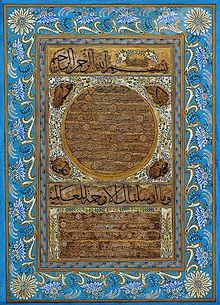 Hilye by Hâfiz Osman (1642–1698)
Hilye by Hâfiz Osman (1642–1698)
In one of the earliest sources, Ibn Sa'd's Kitab al-Tabaqat al-Kabir, there are numerous verbal descriptions of Muhammad. One description sourced to Ali ibn Abi Talib is as follows:
- The Apostle of Allah, may Allah bless him, is neither too short nor too tall. His hair are neither curly nor straight, but a mixture of the two. He is a man of black hair and large skull. His complexion has a tinge of redness. His shoulder bones are broad and his palms and feet are fleshy. He has long al-masrubah which means hair growing from neck to navel. He is of long eye-lashes, close eyebrows, smooth and shining fore-head and long space between two shoulders. When he walks he walks inclining as if coming down from a height. I never saw a man like him before him or after him.[19]
Athar Husain gives a non-pictorial description of his appearance, dress, etc. in "The Message of Mohammad". According to Husain, Muhammad was a little taller than average, sturdily built, and muscular. His fingers were long. His hair, which was long, had waves, and he had a thick beard, which had seventeen gray hairs at the time of his death. He had good teeth and spare cheeks, and brownish-black eyes. His complexion was fair and he was very handsome. He walked fast with firm gait. He always kept himself busy with something, did not speak unnecessarily, always spoke to the point and without verbosity, and did not behave in an emotional way. He usually wore a shirt, trousers, a sheet thrown round the shoulders, and a turban, all spotlessly clean, rarely wearing the fine clothes that had been presented to him. He wanted others to wear simple, but always clean, clothes.[20]
The Arabic term for a written description of Muhammad is a hilya (Turkish: hilye, pl. hilyeler), and in the Ottoman period such texts may be surrounded by an elaborate frame of illuminated decoration, either in books or, more often, muraqqas or albums, or sometimes placed in wooden frames so that they can hang on a wall.[21] The elaborated form of the calligraphic tradition was founded in the 17th century by the Ottoman calligrapher Hâfiz Osman. While containing a concrete and artistically appealing description of Muhammad's appearance, they complied with the strictures against figurative depictions of the Prophet, leaving his appearance to the viewer's imagination.[22][23] The Ottoman hilye format customarily starts with a basmala, shown on top, and is separated in the middle by Quran 21:107: "And We have not sent you but as a mercy to the worlds".[23] The four circles often contain the names of the Rightly-guided Caliphs, Abu Bakr, Umar, Uthman, and Ali, each followed by "radhi Allahu anhu" ("may God be pleased with him").
Calligraphic representations
The most common visual representation of the Prophet in Islamic art, especially in Arabic-speaking areas, is by a calligraphic representation of his name, a sort of monogram in roughly circular form, often given a decorated frame. Such inscriptions are normally in Arabic, and may rearrange or repeat forms, or add a blessing or honorific, or for example the word "messenger" or a contraction of it. The range of ways of representing Muhammad's name is considerable, including ambigrams.
The more elaborate versions relate to other Islamic traditions of special forms of calligraphy such as those writing the names of God, and the secular tughra or elaborate monogram of Ottoman rulers.
-
Muhammad's name in Thuluth, Arabic calligraphic script; the smaller writing in the top left means "Peace be upon him"
Figurative visual depictions
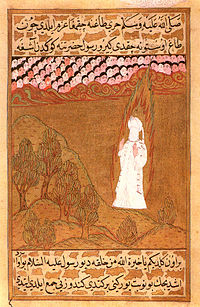 Muhammad, shown with a veiled face and halo, at Mount Hira (16th century Ottoman illustration of the Siyer-i Nebi)
Muhammad, shown with a veiled face and halo, at Mount Hira (16th century Ottoman illustration of the Siyer-i Nebi)
Throughout Islamic history, depictions of Muhammad in Islamic art were rare.[12] According to Christiane Gruber, there exists a "notable corpus of images of Muhammad produced, mostly in the form of manuscript illustrations, in various regions of the Islamic world from the thirteenth century through modern times".[24] Depictions of Muhammad date back to the start of the tradition of Persian miniatures as illustrations in books. The illustrated book from the Persianate world (Warka and Gulshah, Topkapi Palace Library H. 841, attributed to Konya 1200-1250) contains the two earliest known Islamic depictions of the Prophet.[25] This book dates to before or just around the time of the Mongol invasion of Anatolia in the 1240s, and before the campaigns against Persia and Iraq of the 1250s, which destroyed great numbers of books in libraries.
Gruber traces a development from "veristic" images showing the whole body and face, in the 13th to 15th centuries, to more "abstract" representations in the 16th to 19th centuries, the latter including the representation of the Prophet by a special type of calligraphic reresentation, with the older types also remaining in use.[26] An intermediate type, first found from about 1400, is the "inscribed portrait" where the face of Muhammad is blank, with "Ya Muhammad" ("O Muhammad") or a similar phrase written in the space instead; these may be related to Sufi thought. In some cases the inscription appears to have been a underpainting that would later be covered by a face or veil, so a pious act by the painter, for his eyes alone, but in others it was intended to be seen.[27] According to Gruber, a good number of these paintings, however, underwent later iconoclastic mutilations, in which the facial features of the Prophet were scratched or smeared" as Muslim views on the acceptability of veristic images changed.[28]
A number of extant Persian manuscripts representing Muhammad date from the Ilkhanid period under the new Mongol rulers, including a Marzubannama dating to 1299. The Ilkhanid MS Arab 161 of 1307/8 contains 25 illustrations found in an illustrated version of Al-Biruni's The Remaining Signs of Past Centuries, of which five include depictions Muhammad, including the two concluding images, the largest and most accomplished in the manuscript, which emphasize the relation of Muhammad and `Ali according to Shi`ite doctrine.[29] According to Christiane Gruber, other works use images to promote Sunni Islam, such as a set of Mi'raj illustrations (MS H 2154) in the early 14th century,[30] although other historians have dated the same illustrations to the Jalayrid period of Shia rulers.[31]
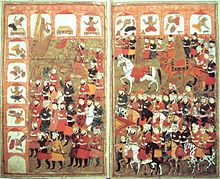 The destruction of idols at the Kaaba. Muhammad (top left and mounted at right)[citation needed] is represented as a flaming aureole. From Hamla-i haydarî ("Haydar's Battle"), Kashmir, 1808.
The destruction of idols at the Kaaba. Muhammad (top left and mounted at right)[citation needed] is represented as a flaming aureole. From Hamla-i haydarî ("Haydar's Battle"), Kashmir, 1808.
Depictions of Muhammad are also found in Persian manuscripts in the following Timurid and Safavid dynasties, and Turkish Ottoman art in the 14th to 17th centuries, and beyond. Perhaps the most elaborate cycle of illustrations of Muhammad's life is the late 16th century copy of the 14th century biography Siyer-i Nebi commissioned by the Ottoman sultan Murat III for his son, the future Mehmed III, containing over 800 illustrations.[32]
Probably the commonest narrative scene represented is the Mi'raj; according to Gruber, "There exist countless single-page paintings of the meʿrāj included in the beginnings of Persian and Turkish romances and epic stories produced from the beginning of the 15th century to the 20th century".[33] These images were also used in celebrations of the anniversary of the Mi'raj on 27 Rajab, when the accounts were recited aloud to male groups: "Didactic and engaging, oral stories of the ascension seem to have had the religious goal of inducing attitudes of praise among their audiences". Such practices are most easily documented in the 18th and 19th centuries, but manuscripts from much earlier appear to have fulfilled the same function.[34] Otherwise a large number of different scenes may be represented at times, from the Prophet's birth to the end of his life, and his existence in Paradise.[35]
In the earliest depictions Muhammad may be shown with or without a halo, the earliest halos being round in the style of Christian art,[36], but before long a flaming halo or aureole in the Buddhist or Chinese tradition becomes more common than the circular form found in the West, when a halo is used. A halo or flame may surround only his head, but often his whole body, and in some images the body itself cannot be seen for the halo. This "luminous" form of representation avoided the issues caused by "veristic" images, and could be taken to convey qualities of the Prophet's person described in texts.[37] If the body is visible, the face may be covered with a veil (see gallery for examples of both types). This form of representation, which began at the start of the Safavid period in Persia,[38] was done out of reverence and respect.[12] Other prophets of Islam, and the Prophet's wives and relations, may be treated in similar ways if they also appear.
T. W. Arnold (1864-1930), an early historian of Islamic art, stated that "Islam has never welcomed painting as a handmaid of religion as both Buddhism and Christianity have done. Mosques have never been decorated with religious pictures, nor has a pictorial art been employed for the instruction of the heathen or for the edification of the faithful."[12] Comparing Islam to Christianity, he also writes: "Accordingly, there has never been any historical tradition in the religious painting of Islam – no artistic development in the representation of accepted types – no schools of painters of religious subjects; least of all has there been any guidance on the part of leaders of religious thought corresponding to that of ecclesiastical authorities in the Christian Church."[12]
Images of the Prophet remain controversial to the present day, and are not considered acceptable in many countries in the Middle East. For example in 1963 an account by a Turkish author of a Hajj pilgrimage to Mecca was banned in Pakistan because it contained reproductions of miniatures showing the Prophet unveiled.[39] However in Iran depictions have considerable acceptance to the present day, and may be found in the modern forms of the poster and postcard.[40]
-
The Investiture of Ali at Ghadir Khumm, MS Arab 161, fol. 162r, AD 1309/8 Ilkhanid manuscript illustration.
-
Muhammad meets the monk Bahira. From Jami Al-Tawarikh ("The Universal History" written by Rashid Al-Din), a manuscript in the Library of the University of Edinburgh; illustrated in Tabriz, Muzaffarid period, c. 1315.
-
Miniature of Muhammad re-dedicating the Black Stone at the Kaaba. From Jami Al-Tawarikh, c. 1315
-
Muhammad's Call to Prophecy and the First Revelation; in the Majmac al-tawarikh (Compendium of Histories), ca. 1425; Timurid, Herat, Afghanistan
-
"Muhammad at the Ka'ba" from Siyer-i Nebi, a 16th-century Ottoman manuscript, probably by Nakkaş Osman.[41] Muhammad is shown with veiled face.
-
A 16th century Persian miniature painting with a veiled Muhammad's ascent into the Heavens, a journey known as the Miraj.
-
Muhammad delivering The Farewell Sermon, 17th century Ottoman copy of an early 14th century Persian image.[42]
-
Mohammad (riding the horse) receiving the submission of the Banu Nadir.
-
"Mohammed's Paradise," Persian miniature from The History of Mohammed, BnF, Paris.
Cinema
Main article: List of films about MuhammadVery few films have depicted Muhammad. The only modern one to do so was the 1976 The Message, also known as Mohammad, Messenger of God. The movie focused on other persons and never directly showed Muhammad, or most members of his family. When Muhammad was essential to a scene, the camera would show events from his point of view.[43]
Two well-known fatwas from Al-Azhar University and Shiite Council of Lebanon were issued about The Message.
- "It is certainly probable that this is not the result of the creativity of the filmmakers but of the rules announced by the Islamic scholars of the Azhar and the Shiite Council of Lebanon, who prohibited any representation of Muhammad's wives as well as of the Prophet himself."[43]
A more severe case occurred in Egypt in 1926, around the anticipated production of a film about the grandeur of the early days of Islam. Upon learning of this plan, the Islamic Al-Azhar University in Cairo alerted Egyptian public opinion, and published a juridical decision (fatwa), stipulating that Islam categorically forbids the representation of Muhammad and his companions on the screen. King Fauad sent a severe warning to actor Youssef Wahbi, threatening to exile him and strip him of his Egyptian nationality.[44]
Other contemporary Shi'a scholars, outside Shi'a majority Iran, have taken a relaxed attitude towards pictures of Muhammad and his household, the Ahlul Bayt. A fatwa given by Ali al-Sistani, the Shi'a marja of Iraq, states that it is permissible to depict Muhammad, even in television or movies, if done with respect.[45] A devotional cartoon called Muhammad: The Last Prophet was released in 2004.[46]
Depiction by non-Muslims
Muhammad figures frequently in depictions of influential people in world history. Such depictions tend to be favourable or neutral in intent; one example can be found at the United States Supreme Court building in Washington, D.C.. A frieze including major historical lawgivers places Muhammad alongside Hammurabi, Moses, Confucius, and others. Because of a 1997 controversy surrounding the frieze, tourist materials have been edited so they call the depiction "a well-intentioned attempt by the sculptor to honor Muhammad" that "bears no resemblance to Muhammad."[47] In 1955, a statue of Muhammad was removed from a courthouse in New York City after the ambassadors of Indonesia, Pakistan, and Egypt requested its removal.[48]
There have also been numerous book illustrations showing Muhammad.
Dante, in The Divine Comedy: Inferno, placed Muhammad in Hell, with his entrails hanging out (Canto 28):
- No barrel, not even one where the hoops and staves go every which way, was ever split open like one frayed Sinner I saw, ripped from chin to where we fart below.
- His guts hung between his legs and displayed His vital organs, including that wretched sack Which converts to shit whatever gets conveyed down the gullet.
- As I stared at him he looked back And with his hands pulled his chest open, Saying, "See how I split open the crack in myself! See how twisted and broken Mohammed is! Before me walks Ali, his face Cleft from chin to crown, grief–stricken."[49]
This scene is frequently shown in illustrations of the Divina Commedia. For example it is represented in a 15th century fresco in Bologna, Italy, in the Church of San Petronio,[50] and artwork by Salvador Dalí, Auguste Rodin, William Blake, and Gustave Doré.[51]
-
Portrait of Muhammad as a generic "Easterner", from the PANSEBEIA, or A View of all Religions in the World by Alexander Ross (1683).
-
An engraving of Muhammad in The Life of Mahomet (1719).
-
William Blake, Muhammad pulling his chest open in an illustration to Dante's Inferno (1827).
-
Muhammad as depicted by sculptor Adolph Weinman on the U.S. Supreme Court building in Washington, DC carrying a sword and the Quran.
-
Renaissance fresco illustrating the negative view of Islam held by Europeans. Muhammad is depicted being tortured in Hell.
-
Muhammed and the Monk Sergius (Bahira). This 1508 engraving by the Dutch artist Lucas van Leyden shows a legend that circulated in Europe.
Recent controversies
The start of the 21st century has been marked by controversies over depictions of Muhammad, not only for recent caricatures or cartoons, but also regarding the display of historical artwork. In 2002, Italian police reported that they had disrupted a terrorist plot to destroy a church in Bologna, which contains a 15th century fresco depicting an image of Muhammad.[50][52] In 2005, worldwide media attention focused on the controversy surrounding a dozen editorial cartoons published in the Jyllands-Posten.
Cartoons
Further information: Jyllands-Posten Muhammad cartoons controversyIn 2005, a Danish newspaper published a set of editorial cartoons, many of which depicted Muhammad. In late 2005 and early 2006, Danish Muslim organizations ignited a controversy through public protests and by spreading knowledge of the publication of the cartoons.[16] According to John Woods, Islamic history professor at the University of Chicago, it was not simply the depiction of Muhammad that was offensive, but the implication that Muhammad was somehow a supporter of terrorism.[18] On 12 February 2008 the Danish police arrested three men alleged to be involved in a plot to assassinate Kurt Westergaard, one of the cartoonists.[53]
In 2005, an episode of 30 Days with Morgan Spurlock, titled "Muslims and America," depicted Muhammad twice, in a cartoon explaining the origins of the Islamic faith. There was no outcry over this.[citation needed] In 2006, the controversial American animated television comedy program South Park, which had previously depicted Muhammad as a superhero character in the July 4, 2001 episode "Super Best Friends"[54] and has depicted Muhammad in the opening sequence since that episode,[55] attempted to satirize the Danish newspaper incident. In the episode "Cartoon Wars Part II", they intended to show Muhammad handing a salmon helmet to Peter Griffin, a character in the Fox animated television show Family Guy. However, Comedy Central, the parent company of South Park, rejected the scene, citing concerns of violent protests in the Islamic world. The creators of South Park reacted by instead satirizing Comedy Central's double standard for broadcast acceptability by including a segment in which American president George W. Bush and Jesus defecate on the flag of the United States.
 Muhammad appeared in the 2001 South Park episode "Super Best Friends". The prophet's image was later removed from the 2006 episode "Cartoon Wars" and the 2010 episodes "200" and "201" due to controversies regarding Muhammad cartoons in European newspapers.
Muhammad appeared in the 2001 South Park episode "Super Best Friends". The prophet's image was later removed from the 2006 episode "Cartoon Wars" and the 2010 episodes "200" and "201" due to controversies regarding Muhammad cartoons in European newspapers.
The Lars Vilks Muhammad drawings controversy began in July 2007 with a series of drawings by Swedish artist Lars Vilks which depicted Muhammad as a roundabout dog. Several art galleries in Sweden declined to show the drawings, citing security concerns and fear of violence. The controversy gained international attention after the Örebro-based regional newspaper Nerikes Allehanda published one of the drawings on August 18 to illustrate an editorial on self-censorship and freedom of religion.[56] While several other leading Swedish newspapers had published the drawings already, this particular publication led to protests from Muslims in Sweden as well as official condemnations from several foreign governments including Iran,[57] Pakistan,[58] Afghanistan,[59] Egypt[60] and Jordan,[61] as well as by the inter-governmental Organisation of the Islamic Conference (OIC).[62] The controversy occurred about one and a half years after the Jyllands-Posten Muhammad cartoons controversy in Denmark in early 2006.
Another controversy emerged in September 2007 when Bangladeshi cartoonist Arifur Rahman was detained on suspicion of showing disrespect to Muhammad. The interim government confiscated copies of the Bengali-language Prothom Alo in which the drawings appeared. The cartoon consisted of a boy holding a cat conversing with an elderly man. The man asks the boy his name, and he replies "Babu". The older man chides him for not mentioning the name of Muhammad before his name. He then points to the cat and asks the boy what it is called, and the boy replies "Muhammad the cat". The cartoon caused a firestorm in Bangladesh, with militant Islamists demanding that Rahman be executed for blasphemy. A group of people torched copies of the paper and several Islamic groups protested, saying the drawings ridiculed Mohammad and his companions. They demanded "exemplary punishment" for the paper's editor and the cartoonist. Bangladesh, however, does not have a blasphemy law, although one had been demanded by the same extremist Islamic groups.
Sooreh Hera
In December 2007, controversy erupted in the Netherlands when Iranian artist Sooreh Hera exhibited photos of two Iranian gay men in a series of sexually provocative positions, wearing masks depicting Muhammad and his son-in-law Ali. The photo series was intended to highlight the hypocrisy the artist saw, of Muslim married men engaging in sexual relations with other men. The Hague Municipal Museum expressed interest in buying the series, but refused to display it, citing fear that it could "offend certain groups". Dutch politician Geert Wilders, leader of the Partij voor de Vrijheid (Party for Freedom), excoriated the museum's decision, saying it was "based on fear".[63]
Wikipedia article
In 2008, several Muslims protested against the inclusion of Muhammad's depictions in Wikipedia's Muhammad article.[64][65] An online petition claims to have collected over 450,000 signatures in three months (December 2007 to February 2008). The petition was started by Faraz Ahmad of Daska, Pakistan, resident in Glasgow, formerly editing Wikipedia as "Farazilu". The petition specifies opposition to a reproduction of a 17th century Ottoman copy of a 14th century Ilkhanate manuscript image (MS Arabe 1489) depicting Muhammad as he prohibited Nasīʾ, a special form of intercalary months practiced in Arabia.[66] Jeremy Henzell-Thomas of The American Muslim deplored the petition as one of "these mechanical knee-jerk reactions" which, "are gifts to those who seek every opportunity to decry Islam and ridicule Muslims and can only exacerbate a situation in which Muslims and the Western media seem to be locked in an ever-descending spiral of ignorance and mutual loathing".[67]
Wikipedia considered but rejected a compromise that would allow visitors to choose whether to view the page with images.[65] The Wikipedia community has not acted upon the petition.[68] The site's answers to frequently asked questions about these images state that Wikipedia does not censor itself for the benefit of any one group.[69]
Metropolitan Museum of Art
The Metropolitan Museum of Art in January 2010 confirmed to the New York Post that it had quietly removed all historic paintings which contained depictions of Muhammad from public exhibition. The Museum quoted objections on the part of conservative Muslims which were "under review." The museum's action was criticized as excessive political correctness, also apparent in other recent decision, including the renaming of the "Primitive Art Galleries" to the "Arts of Africa, Oceania and the Americas" and the projected "Islamic Galleries" to "Arab Lands, Turkey, Iran, Central Asia and Later South Asia".[70]
Everybody Draw Mohammed Day
Main article: Everybody Draw Mohammed DayEverybody Draw Mohammed Day was a protest against those who threatened violence against artists who drew representations of Muhammad. It began as a protest against the action of Comedy Central in forbidding the broadcast of the South Park episode "201" in response to death threats against some of those responsible for the segment. Observance of the day began with a drawing posted on the Internet on April 20, 2010, accompanied by text suggesting that "everybody" create a drawing representing Muhammad, on May 20, 2010, as a protest against efforts to limit freedom of speech.
See also
- Controversial depictions
Notes
- ^ a b T. W. Arnold (June 1919). "An Indian Picture of Muhammad and His Companions". The Burlington Magazine for Connoisseurs, Vol. 34, No. 195.. pp. 249–252. http://links.jstor.org/sici?sici=0951-0788%28191906%2934%3A195%3C249%3AAIPOMA%3E2.0.CO%3B2-6. Retrieved 2007-05-01.
- ^ Jonathan Bloom & Sheila Blair (1997). Islamic Arts. London: Phaidon. pp. 202.
- ^ a b Devotion in pictures: Muslim popular iconography – The prophet Muhammad, University of Bergen
- ^ Thomas Walker Arnold says that
- "It was not merely Sunni schools of law but Shia jurists also who fulminated against this figured art. Because the Persians are Shiites, many Europeans writers have assumed that the Shia sect had not the same objection to representing living being as the rival set of the Sunni; but such an opinion ignores the fact that Shiisum did not become the state church in Persia until the rise of the Safivid dynasty at the beginning of the 16th century."
- ^ "Islamic Figurative Art and Depictions of Muhammad". religionfacts.com. http://www.religionfacts.com/islam/things/depictions-of-muhammad-in-islamic-art.htm. Retrieved 2007-07-06.
- ^ Gruber (2010), p.27
- ^ Cosman, Pelner and Jones, Linda Gale. Handbook to life in the medieval world, p. 623, Infobase Publishing, ISBN 0816048878, 9780816048878
- ^ Gruber (2010), p.27 (quote) and 43
- ^ Gruber (2005), pp. 239, 247–253
- ^ Brendan January (1 February 2009). The Arab Conquests of the Middle East. Twenty-First Century Books. p. 34. ISBN 978-0-8225-8744-6. http://books.google.com/books?id=K9XGWkkFy0sC&pg=PA34. Retrieved 14 November 2011.
- ^ Omid Safi (2 November 2010). Memories of Muhammad: Why the Prophet Matters. HarperCollins. p. 171. ISBN 978-0-06-123135-3. http://books.google.com/books?id=s63i21E9dr8C&pg=PA171. Retrieved 14 November 2011.
- ^ a b c d e Arnold, Thomas W. (First published 1928, reprint 2002-11). Painting in Islam, a Study of the Place of Pictorial Art in Muslim Culture. Gorgias Press LLC. pp. 91–9. ISBN 9781931956918.
- ^ a b Dirk van der Plas (1987). Effigies dei: essays on the history of religions. BRILL. p. 124. ISBN 978-90-04-08655-5. http://books.google.com/books?id=ops3AAAAIAAJ&pg=PA124. Retrieved 14 November 2011.
- ^ a b Ernst, Carl W. (August 2004). Following Muhammad: Rethinking Islam in the Contemporary World. UNC Press Books. pp. 78–79. ISBN 978-0-8078-5577-5. http://books.google.com/books?id=DOWn22EkJsQC&pg=PA78. Retrieved 14 November 2011.
- ^ Devotion in pictures: Muslim popular iconography – Introduction to the exhibition, University of Bergen
- ^ a b Richard Halicks (2006-02-12). "Images of Muhammad: Three ways to see a cartoon". Atlanta Journal-Constitution.
- ^ Office of the Curator (2003-05-08). "Courtroom Friezes: North and South Walls" (pdf). Information Sheet, Supreme Court of the United States. http://www.supremecourt.gov/about/north&southwalls.pdf. Retrieved 2007-07-08.
- ^ a b "Explaining the outrage". Chicago Tribune. 2006-02-08.
- ^ Ibn Sa'd – Kitabh al-Tabaqat al-Kabir, as translated by S. Moinul and H.K. Ghazanfar, Kitab Bhavan, New Delhi, n.d.
- ^ "USC-MSA Compendium of Muslim Texts". http://www.usc.edu/dept/MSA/fundamentals/prophet/prophetdescription.html. Retrieved 2006-03-10.
- ^ Gruber (2005), p.231-232
- ^ F. E. Peters (10 November 2010). Jesus and Muhammad: Parallel Tracks, Parallel Lives. Oxford University Press. pp. 160–161. ISBN 978-0-19-974746-7. http://books.google.com/books?id=olEi-1LZYYQC&pg=PA160. Retrieved 5 November 2011.
- ^ a b Jonathan E. Brockopp (30 April 2010). The Cambridge companion to Muḥammad. Cambridge University Press. p. 130. ISBN 978-0-521-71372-6. http://books.google.com/books?id=o58K2t344YQC&pg=PA130. Retrieved 6 November 2011.
- ^ Gruber (2005), p. 240-241
- ^ Grabar, p. 19; Gruber (2005), p. 235 (from where the date range), Blair, Sheila S., The Development of the Illustrated Book in Iran, Muqarnas, Vol. 10, Essays in Honor of Oleg Grabar (1993), p. 266, BRILL, JSTOR says "c. 1250"
- ^ Gruber (2005), 229, and throughout
- ^ Gruber (2005), p. 240-241
- ^ Gruber (2005), 229
- ^ Gruber (2010), pp.27-28
- ^ Gruber (2010), quote p. 43; generally pp.29-45
- ^ Gruber, Christiane (2010-03-15). The Ilkhanid Book of Ascension. Tauris Academic Studies. p. 25. ISBN 184511499X.
- ^ Tanındı, Zeren (1984). Siyer-i nebî: İslam tasvir sanatında Hz. Muhammedʹin hayatı. Hürriyet Vakfı Yayınları.
- ^ Gruber (Iranica)
- ^ Gruber (2010), p.43
- ^ The birth is rare, but appears in an early manuscript in Edinburgh
- ^ Arnold, 95
- ^ Gruber, 230, 236
- ^ Brend, Barbara. Islamic Art, p. 161, British Museum Press.
- ^ Schimmel, Annemarie, Deciphering the signs of God: a phenomenological approach to Islam, p.45, n. 86, SUNY Press, 1994, ISBN 0791419827, 9780791419823
- ^ Gruber (2010), p.253, illustrates a postcard bought in 2001.
- ^ http://www.ee.bilkent.edu.tr/~history/ottoman33.html
- ^ From an illustrated version of Al-Biruni's 11th c. Vestiges of the Past (Bibliothèque Nationale, Paris, Arabe 1489 fol. 5v. (Bibliothèque Nationale on-line catalog Mandragore
- ^ a b Freek L. Bakker (January 2006). "The image of Muhammad in The Message, the first and only feature film about the Prophet of Islam" (pdf). Routledge, "Islam and Christian-Muslim Relations", Vol. 17, No.1. http://taylorandfrancis.metapress.com/index/L7M5247402032139.pdf. Retrieved 2007-07-06.
- ^ Alessandra. Raengo & Robert Stam (2004). A Companion To Literature And Film. Blackwell Publishing. pp. 31. ISBN 063123053X.
- ^ "Istifta". http://www.sistani.org/html/eng/menu/4/?lang=eng&view=d&code=234&page=1. Retrieved 2006-03-10.
- ^ "Fine Media Group". http://www.finemediagroup.com/user/finemedia/press.cfm. Retrieved 2006-03-11.
- ^ "The Daily Republican: Supreme Court Frieze". http://www.dailyrepublican.com/sup_crt_frieze.html. Retrieved 2006-03-13.
- ^ "Archive "Montreal News Network": Images of Muhammad, Gone for Good". http://www.yourmailinglistprovider.com/pubarchive_show_message.php?montrealmuslimnews+7289. Retrieved 2006-03-10.[dead link]
- ^ Seth Zimmerman (2003). The Inferno of Dante Alighieri. iUniverse. p. 191. ISBN 0-595-28090-0. http://books.google.com/books?id=r3hWDEjN7JcC&pg=PA191#v=onepage&q&f=false.
- ^ a b Philip Willan (2002-06-24). "Al-Qaida plot to blow up Bologna church fresco". The Guardian. http://arts.guardian.co.uk/news/story/0,11711,742914,00.html.
- ^ Ayesha Akram (2006-02-11). "What's behind Muslim cartoon outrage". San Francisco Chronicle. http://sfgate.com/cgi-bin/article.cgi?file=/c/a/2006/02/11/MNGRCH6UQK1.DTL.
- ^ "Italy frees Fresco Suspects". New York Times. 2002-08-22. http://query.nytimes.com/gst/fullpage.html?res=9D0CE2D9163CF931A1575BC0A9649C8B63.
- ^ Staff. Danish cartoons 'plotters' held BBC, 12 February 2008
- ^ "Super Best Friends". South Park. 2001-07-04. No. 68, season 5.
- ^ Ryan j Budke. "South Park's been showing Muhammad all season!" TVSquad.com; April 15, 2006
- ^ Ströman, Lars (2007-08-18). "Rätten att förlöjliga en religion" (in Swedish). Nerikes Allehanda. Archived from the original on 2007-09-06. http://web.archive.org/web/20070906190721/http://www.na.se/artikel.asp?intId=1209627. Retrieved 2007-08-31.
English translation: Ströman, Lars (2007-08-28). "The right to ridicule a religion". Nerikes Allehanda. Archived from the original on 2007-08-30. http://web.archive.org/web/20070830163657/http://www.na.se/artikel.asp?intId=1209676. Retrieved 2007-08-31. - ^ "Iran protests over Swedish Muhammad cartoon". Agence France-Presse. 2007-08-27. http://www.thelocal.se/8305/20070827/. Retrieved 2007-08-27.
- ^ "PAKISTAN CONDEMNS THE PUBLICATION OF OFFENSIVE SKETCH IN SWEDEN" (Press release). Pakistan Ministry of Foreign Affairs. 2007-08-30. http://www.mofa.gov.pk/Press_Releases/2007/Aug/PR_234_07.htm. Retrieved 2007-08-31.
- ^ Salahuddin, Sayed (2007-09-01). "Indignant Afghanistan slams Prophet Mohammad sketch". Reuters. http://in.reuters.com/article/SouthAsiaNews/idINIndia-29281220070901. Retrieved 2007-09-09.
- ^ Fouché, Gwladys (2007-09-03). "Egypt wades into Swedish cartoons row". The Guardian. http://media.guardian.co.uk/presspublishing/story/0,,2161595,00.html. Retrieved 2007-09-09.
- ^ "Jordan condemns new Swedish Mohammed cartoon". Agence France-Presse. 2007-09-03. http://news.yahoo.com/s/afp/20070903/wl_mideast_afp/jordanswedenislam_070903124623. Retrieved 2007-09-09.[dead link]
- ^ "The Secretary General strongly condemned the publishing of blasphemous caricatures of prophet Muhammad by Swedish artist" (Press release). Organisation of the Islamic Conference. 2007-08-30. http://www.oic-oci.org/press/English/2007/08/caricatur.htm. Retrieved 2007-09-09.
- ^ "Allah o gay bar"; gayswithoutborders.com; Retrieved on 2007-12-06
- ^ "Muslims Protest Wikipedia Images of Muhammad". Fox News. 2008-02-06. http://www.foxnews.com/story/0,2933,328966,00.html. Retrieved 2008-02-07.
- ^ a b Noam Cohen (2008-02-05). "Wikipedia Islam Entry Is Criticized". New York Times. http://www.nytimes.com/2008/02/05/books/05wiki.html. Retrieved 2008-02-07.
- ^ MS Arabe 1489. The image used by Wikipedia is hosted on Wikimedia Commons (upload.wikimedia.org/wikipedia/commons/0/0d/Maome.jpg). The reproduction originates from the website of the Bibliothèque nationale de France [1].
- ^ Wikipedia and Depictions of the Prophet Muhammad: The Latest Inane Distraction, 10 February 2008
- ^ Wikipedia defies 180,000 demands to remove images of the Prophet The Guardian 17 February 2008
- ^ Wikipedia Refuses To Delete Picture Of Muhammad Information Week 7 February 2008.
- ^ 'Jihad' jitters at Met – Mohammed art gone by Isabel Vincent, 10 January 2010.
References
- Arnold, Thomas W. ((First published 1928, reprint 2002-11). Painting in Islam, a Study of the Place of Pictorial Art in Muslim Culture. Gorgias Press LLC. pp. 91–9. ISBN 9781931956918.
- Ali, Wijdan (23–28 August), M. Kiel, N. Landman, and H. Theunissen, ed., "From the Literal to the Spiritual: The Development of Prophet Muhammad's Portrayal from 13th Century Ilkhanid Miniatures to 17th Century Ottoman Art" (PDF), Proceedings of the 11th International Congress of Turkish Art (The Netherlands: Utrecht) 7 (1–24): 7, archived from the original on 2007-12-01, http://web.archive.org/web/20071201123841/http://www2.let.uu.nl/Solis/anpt/ejos/pdf4/07Ali.pdf
- Grabar, Oleg, The Story of Portraits of the Prophet Muhammad, in Studia Islamica, 2004, p. 19 onwards.
- "Gruber (2005)", Gruber, Christiane, Representations of the Prophet Muhammad in Islamic painting, in Gulru Necipoglu, Karen Leal eds., Muqarnas, Volume 26, 2009, BRILL, ISBN 900417589X, 9789004175891, google books
- "Gruber (2010)", Gruber, Christiane J., The Prophet's ascension: cross-cultural encounters with the Islamic mi'rāj tales, Christiane J. Gruber, Frederick Stephen Colby (eds), Indiana University Press, 2010, ISBN 0253353610, 9780253353610, google books
- "Gruber (Iranica)", Gruber, Christiane, "MEʿRĀJ ii. Illustrations", in Encyclopedia Iranica, 2009, online
External links
- Devotion in pictures: Muslim popular iconography, University of Bergen
- "Religious" Paintings in Islamic Art
- Mohammed Image Archive: Depictions of Mohammed Throughout History
- Mohammed in Virgil's Inferno 28
Categories:- Depictions of Muhammad
- Iconography
- Idolatry
- Censorship in Islam
Wikimedia Foundation. 2010.


















